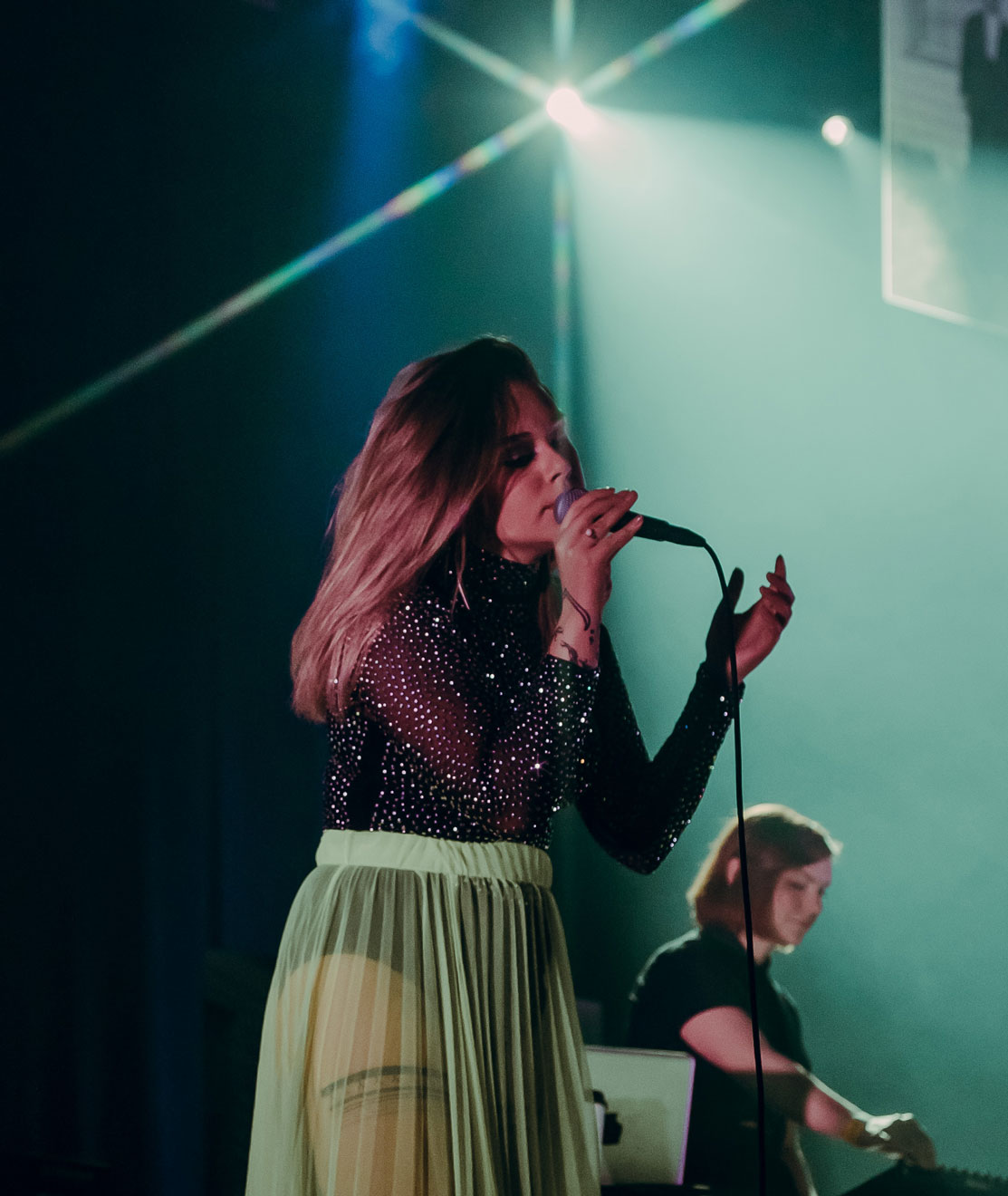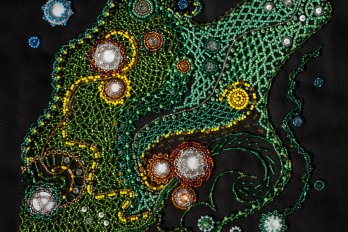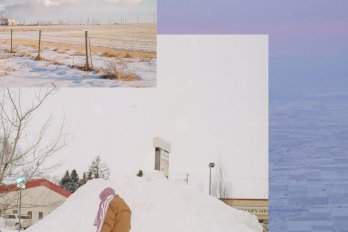Deep in the mazy grey passages of Toronto’s CBC headquarters, Nunavut-born throat singer Riit is gleaming. She’s in studio to record some songs from her debut album, Ataataga. From my perch in the sound booth, I listen as she and her co-singer, Alexia Galloway-Alainga, move between luscious Inuktitut harmonies and the commanding thunder of throat singing—their vocals steadied by the pulse of electronic beats. This fusion feels energizing: tradition meets a party scene on a zesty TV melodrama.
Inuit throat singing typically features two people who alternate between quick, rhythmic breaths to produce sonic layers, from high-pitched tones to hoarse, guttural expressions. As Riit and Galloway-Alainga work through the tracks, they switch back and forth: Riit often takes the lead on the melody, while Galloway-Alainga anchors the song with solo throat singing. Sometimes throat singing is the focus, sometimes it’s the structure. At the end of the album’s title song, the backing music falls away, and Riit and Galloway-Alainga face off, allowing the listener to hear the power of Inuit throat singing on its own. For almost a minute, the singers intricately counter each other. The song ends only when they erupt into laughter. “I almost burped!” exclaims Riit. She makes a tilted hand motion to her manager, signalling that she’d like the wine brought in from her dressing room.
For the taping, Riit and Galloway-Alainga selected bright-green skirts that they found at an eccentric Queen West dress shop—the colour glows in the darkness of the studio, its shade as likely to be found on a club-district tube top as within a wave of the Northern Lights. I later search a colour wheel until I find the exact hue: Arctic Lime.
The week prior to the CBC performance, twenty-four-year-old Riit—full name Rita Claire Mike-Murphy—was in her hometown of Panniqtuuq, a hamlet near a fjord in the Qikiqtaaluk Region. Panniqtuuq, fifty kilometres south of the Arctic Circle and with a population of around 1,500, is often called “the Switzerland of the Arctic” owing to the mountains and majestic swaths of glacial blues that ornament its horizon. Riit was briefly enjoying a reprieve from a touring schedule that had sent her through Canada and Europe. She spent her days hiking, fishing, and preparing country food like seal and maktaaq—whale skin and blubber.
Riit first made a name for herself in 2017, after releasing a self-titled, home-recorded three-song EP that Exclaim! described as “an enchanting blend of mellow folk-rock.” It earned nominations at the Indigenous Music Awards and the Western Canadian Music Awards and is still proudly on display in the Iqaluit Airport gift shop.
But, when writing Ataataga, which was released last October, she embarked toward a different sound—exchanging the light, guitar-focused folk stylings that had brought her early recognition for a more danceable design.
This mix of traditional throat singing and perimeter-pushing experimentation has led to an eclectic performance history. Last March, Riit and Galloway-Alainga travelled to London to perform for the Duke and Duchess of Sussex at a private embassy showcase. The following night, they were in Paris for a UNESCO event. Then, in October, Riit opened for Wolastoqiyik musician Jeremy Dutcher’s sold-out show at Toronto’s Danforth Music Hall, which has a capacity of nearly 1,500.
When I begin to ask if she’s endured any pushback for her evolving style, Riit answers before I can complete the question. “Like I’m sinning?” she says, noting that most people have been supportive. Last summer, she plotted a mini-tour of Nunavut, swapping marquee venues for elementary-school gymnasiums. She played in Iqaluit, Baker Lake, and Chesterfield Inlet—the latter with a total population of about 440. “This was their first time hearing my new music, going from Inuktitut folky pop to sticky electronic,” she says. “I could tell some were so confused, like, ‘Do I like this?’ In southern Canada, people love it. And then, playing the shows back home, they’re like, ‘What is this?’ But it makes sense—it’s a completely new sound for Inuktitut music.”
Inuit throat singing dates back generations as a way for two women to connect and pass the time while others were out hunting. It originated as a friendly competition: the winner was the last singer to stumble or laugh.
In the eighteenth century, Christian missionaries started arriving in the North and sought to repress Inuit arts, culture, and language. As part of their campaign, they banned the practice.
Throat singing’s public resurgence began in the 1980s, and in the following decades, younger generations worked with Elders to learn traditions that were under threat of being lost. Its revival is as much a musical movement as it is proof of what can be reclaimed.
Riit spent her childhood learning throat singing techniques from her cousin, singer Becky Qilavvaq. “One thing she said that stuck with me was, ‘Don’t be afraid to go super guttural and deep,’” Riit says. “That’s the type of throat singing that I personally am amazed by.”
There are a range of different forms of throat singing practised around the world. Tuvan singers, from central Asia, are famous for their ability to generate multiple sounds at the same time; South African Xhosa singers perform complex rhythms that rely on two basic notes.
What sets Inuit singers apart, says Qilavvaq, is their ability to change sounds in quick succession: a master can go from deep and bass-heavy to bright and birdlike almost instantly. When two or more people sing together, they echo one another’s choices, resulting in an extraordinary range of tones that are simultaneously high and low.
Before Riit started recording Ataataga, she asked her producer, Graham Walsh, to visit Iqaluit. She wanted him to understand the inimitability of Nunavut and the extent to which her home guides her work. While in Iqaluit, he gathered field recordings to include on the album: ravens cawing, footsteps on snow, an ulu knife being sharpened, the sound of caribou meat being sliced. “I wanted to capture as much of the environment as I could,” he says. “Whether overtly or subconsciously, it’s in the music.”
Riit’s reinvigorated direction on Ataataga has won her fans within the music industry—her album was recently nominated for Indigenous Artist or Group of the Year at the 2020 Juno Awards. Chaka V. Grier, writing in Now Magazine, awarded the album four stars out of five and described Riit as “an artist who knows exactly what she wants to say and how she wants to say it.”
This clear-heartedness is evident in Riit’s lead single, a duet with South African Canadian singer Zaki Ibrahim called “#uvangattauq.” In it, they reference the #MeToo movement and call out abusive men: “Auvut tiqtiliqput ijivu ikuallappu takugannu arnami tilluujaqtumi.” (In English: “Our blood starts to boil, our eyes catch on fire, when we see a woman bruised.”) The singers’ ire culminates in a whispered “fuck you,” one of few English lines on the record.
Riit received vitriol for the song online—she felt that the detractors were accusing her of hating men—but she remains undeterred. During live performances, she prefaces her performance of “#uvangattauq” with a call for people to intervene when they witness abuse, alongside a disclosure of her own experience of violence. “When I was going through it, I felt so alone, I felt so deep in the dark,” she told the audience at a recent Toronto show. “I thought it was important to write a song to let other young Inuit women know that I am here supporting you.”
Her message seems to resonate with listeners. “There was this one woman in Winnipeg who came up to me [after the show] and said, ‘I had a really bad fight with my abusive boyfriend last night, and it’s been going on for two years, but today you made me see the light, and I am not going back to him,’” Riit says. “Even if I change ten women’s lives because of the song, that’s a milestone for me.”
When tenor, composer, and pianist Jeremy Dutcher won the 2018 Polaris Music Prize, he used his acceptance speech to declare that Canada was in the midst of “an Indigenous renaissance.” This movement can be seen in the recent history of the Polaris itself: in the past decade, the award has been won by folk idol Buffy Sainte-Marie, genre-defying artist Lido Pimienta, and Tanya Tagaq, whose third album, Animism, was an international hit and brought the term “throat singing” into dozens of headlines around the world.
In northern Canada and beyond, this renaissance has taken hold thanks in part to the 2016 launch of Aakuluk Music, the first Nunavut-based record label. Prior to Aakuluk, there were no managers, booking agents, producers, or publicists who focused on developing and exporting the territory’s musicians, especially those whose lyrics are in Inuktitut. Riit was among the label’s inaugural artists alongside alt-country outfit the Jerry Cans (whose members founded the label), rising pop singer Aasiva, bluesy rockers Josh Q and the Trade-Offs, and Northern Haze, whose 1985 debut marked the first Indigenous-language rock album recorded in North America. (Riit has since signed to Toronto-based Six Shooter Records.)
While Riit’s approach to throat singing is innovative, she is one of several Inuit artists whose style is revitalizing the form. In November, sibling duo Piqsiq, from Yellowknife, released a throat singing Christmas album. Another twosome, the Juno-nominated Silla and Rise, are also incorporating electronic elements into their throat singing sound.
As audiences become acquainted with all the ways throat singing can be performed, Riit, too, continues to bloom. In addition to being a singer, she hosts an educational children’s show on APTN called Anaana’s Tent. And last summer, she spent a month performing in the live theatre show Unikkaaqtuat, working alongside a cast of musicians and circus artists to tell the stories of Inuit founding myths.
“For our performances, I kept drawing this tattoo on with eyeliner,” Riit says, softly dragging her finger down her chin to show where it was placed. The day after the Unikkaaqtuat show in Iqaluit, her friend, Ippiksaut, texted her out of the blue to ask if she wanted a tattoo. Riit had been thinking about getting a design on her thighs. But, when they later met up to start the process, Riit noticed that Ippiksaut kept looking at her face. And so it was determined that Riit would be adorned with tallurutiit: trad-itional chin tattoos. Where Riit is from, it signifies that she has entered womanhood. The art of Inuit face tattoos, like throat singing, had once been banned by colonists. It, too, is now being revitalized. “It was such a powerful experience, being tattooed traditionally,” Riit says. “I feel like I’ve always had it.”





